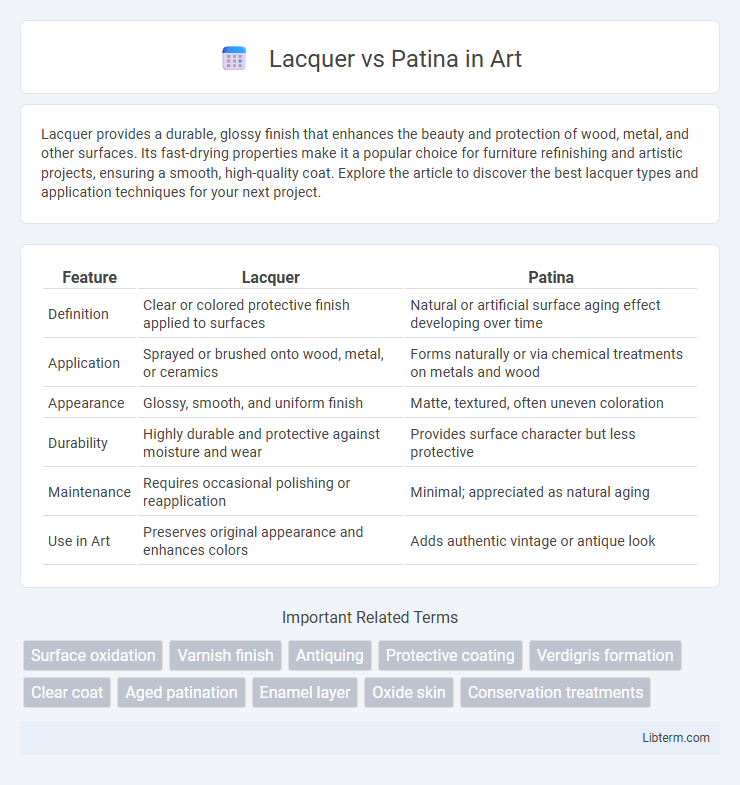Lacquer provides a durable, glossy finish that enhances the beauty and protection of wood, metal, and other surfaces. Its fast-drying properties make it a popular choice for furniture refinishing and artistic projects, ensuring a smooth, high-quality coat. Explore the article to discover the best lacquer types and application techniques for your next project.
Table of Comparison
| Feature | Lacquer | Patina |
|---|---|---|
| Definition | Clear or colored protective finish applied to surfaces | Natural or artificial surface aging effect developing over time |
| Application | Sprayed or brushed onto wood, metal, or ceramics | Forms naturally or via chemical treatments on metals and wood |
| Appearance | Glossy, smooth, and uniform finish | Matte, textured, often uneven coloration |
| Durability | Highly durable and protective against moisture and wear | Provides surface character but less protective |
| Maintenance | Requires occasional polishing or reapplication | Minimal; appreciated as natural aging |
| Use in Art | Preserves original appearance and enhances colors | Adds authentic vintage or antique look |
Understanding Lacquer: Definition and Properties
Lacquer is a clear or colored varnish made from resins dissolved in solvents, providing a durable, glossy finish that dries quickly and forms a hard protective coating. It offers excellent resistance to moisture, chemicals, and wear while enhancing the visual appeal of wood, metal, or other surfaces. Lacquer properties include fast curing, high durability, and the ability to be polished to a high sheen, distinguishing it from the softer, aged finish of patina.
What is Patina? An Overview
Patina is a natural or chemically induced surface layer that develops on metals, wood, or leather over time, enhancing their aesthetic and protective qualities. Unlike lacquer, which forms a clear, hard coating to shield surfaces, patina results from oxidation and environmental exposure, creating unique textures and colors that reflect aging. This process is valued in antiques and art for adding character and depth, making each piece distinctly individual.
Historical Uses: Lacquer vs Patina
Lacquer has been historically used in East Asian art and furniture since ancient China and Japan, providing a durable, glossy finish that protects wood and metal surfaces. Patina develops naturally or through chemical treatments over time on metals like bronze and copper, often valued in European and Middle Eastern artifacts for its indication of age and authenticity. Both finishes serve distinct cultural and functional purposes, with lacquer emphasizing preservation and aesthetics, while patina highlights historical character and provenance.
Aesthetic Differences Between Lacquer and Patina
Lacquer creates a smooth, glossy finish that enhances color vibrancy and provides a sleek, uniform surface, often preferred for modern or high-shine aesthetics. Patina develops naturally or through chemical treatments, resulting in a textured, aged look with rich, varied tones that convey character and historical depth. The choice between lacquer and patina centers on whether a polished, contemporary appearance or a rustic, vintage effect is desired.
Durability and Maintenance Comparison
Lacquer provides a hard, protective coating that resists scratches, moisture, and UV damage, offering superior durability for furniture and wood surfaces. Patina develops naturally over time, adding aesthetic value but requires gentle maintenance to preserve its appearance and avoid damage. Lacquer demands less frequent upkeep, while patina benefits from careful cleaning and occasional conditioning to maintain its character.
Application Techniques for Lacquer and Patina
Application techniques for lacquer involve multiple thin coats applied with a spray gun or brush, allowing each layer to dry and then sanding between coats for a smooth, glossy finish. Patina application requires chemical treatments or natural oxidation processes to develop a unique, aged surface on metals or wood, often applied with a sponge, cloth, or brush to control color intensity and texture. Lacquer creates a protective, shiny surface, while patina emphasizes surface character through controlled corrosion or color change.
Common Materials Treated with Lacquer or Patina
Lacquer is commonly used to finish wood, metal, and automotive parts, providing a durable, glossy protective coating that enhances color and grain visibility. Patina typically develops on metals like copper, bronze, and brass, forming a natural or chemically induced aged layer that offers oxidation resistance and aesthetic appeal. Both treatments preserve materials but serve different visual and protective purposes based on the substrate's properties.
Environmental Impact: Lacquer vs Patina
Lacquer coatings often contain volatile organic compounds (VOCs) that contribute to air pollution and pose health risks during application and drying. Patina, a natural surface oxidation process or applied chemical treatment, generally has a lower environmental footprint due to fewer harmful emissions and less intensive manufacturing. Choosing patina over lacquer supports sustainable practices by reducing chemical waste and promoting eco-friendly finishing methods.
Cost Considerations and Value Over Time
Lacquer offers a lower initial cost compared to patina, making it a budget-friendly choice for surface finishing. Patina, while more expensive upfront, enhances the aesthetic appeal and can increase an item's value over time due to its unique aging process. Investors and collectors often prefer patina finishes for their potential to appreciate, contrasting with lacquer's tendency to degrade and require maintenance.
Choosing Between Lacquer and Patina: Key Factors
Choosing between lacquer and patina hinges on durability, appearance, and maintenance preferences. Lacquer provides a glossy, protective finish that resists moisture and wear, ideal for high-traffic surfaces, while patina offers a natural, aged look formed through oxidation or chemical treatment, valued for its unique aesthetic and character development over time. Consider environmental exposure, desired visual effect, and ease of upkeep when selecting lacquer for a sleek, long-lasting seal or patina for an organic, vintage charm.
Lacquer Infographic

 libterm.com
libterm.com